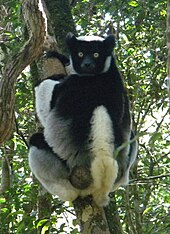User:Emara/sandbox
Cultural
[edit]In Malagasy culture lemurs, and animals in general, have souls (ambiroa) which can get revenge if mocked while alive or if killed in a cruel fashion. Because of this, lemurs, like many other elements of daily life, have been a source of taboos, known locally as fady, which can be based around stories with four basic principles. A village or region may believe that a certain type of lemur may be the ancestor of the clan. They may also believe that a lemur's spirit may get revenge. Alternatively, the animal may appear as a benefactor. Lemurs are also thought to impart their qualities, good or bad, onto human babies.[1] In general, fady extend beyond a sense of the forbidden, but can include events that bring bad luck.[2]

One example of lemur fady told around 1970 comes from Ambatofinandrahana in the Fianarantsoa Province. According to the account, a man brought a lemur home in a trap, but alive. His children wanted to keep the lemur as a pet, but when the father told them it was not a domestic animal, the children asked to kill it. After the children tortured the lemur, it eventually died and was eaten. A short time later, all the children died of illness. As a result, the father declared that anyone who tortures lemurs for fun shall "be destroyed and have no descendants."[1]
Fady can not only help protect lemurs and their forests under stable socioeconomic situations, but they can also lead to discrimination and persecution if a lemur is known to bring bad fortune, for instance, if it walks through town.[3][1] In other ways, fady does not protect all lemurs equally. For example, although the hunting and eating of certain species may be taboo, other species may not share that same protection and are therefore targeted instead.[4][1] Fady can vary from village to village within the same region.[5] If people move to a new village or region, their fady may not apply to the lemur species that are locally present, making them available for consumption. Fady restrictions on lemur meat can be relaxed in times of famine and drought.[3]
The aye-aye is almost universally viewed unfavorably across Madagascar,[2] though the tales vary from village to village and region to region. If people see an aye-aye, they may kill it and hang the corpse on a pole near a road outside of town (so others can carry the bad fortunes away) or burn their village and move.[6][5] The superstitions behind aye-aye fady include beliefs that they kill and eat chickens or people, that they kill people in their sleep by cutting their aortic vein,[3] that they embody ancestral spirits,[5] or that they warn of illness, death, or bad luck in the family.[7][6] As of 1970, the people of the Marolambo District in the Toamasina Province feared the aye-aye because they believed it had supernatural powers. Because of this, no one was allowed to mock, kill, or eat one.[1]
There are also widespread fady about indri and sifakas. They are often protected from hunting and consumption because of their resemblance to humans and their ancestors, mostly due to their large size and upright or orthograde posture. The resemblance is even stronger for indri, which lack the long tail of most living lemurs.[8][9] Known locally as babakoto ("Ancestor of Man"), the indri is sometimes seen as the progenitor of the family or clan. There are also stories of an indri that helped a human down from a tree, so they are seen as benefactors.[1] Other lemur fady include the belief that a wife will have ugly children if her husband kills a woolly lemur, or that if a pregnant woman eats a dwarf lemur, her baby will get its beautiful, round eyes.[1]
Lemurs have also become popular in Western culture in recent years. The original 2005 animated film Madagascar was seen by an estimated 100 million people in theaters and 200–300 million people on DVD worldwide.[10] Prior to this movie, Zoboomafoo, a Public Broadcasting Service (PBS) children's television series from 1999 to 2001,[11] helped to popularize sifakas by featuring a live Coquerel's sifaka from the Duke Lemur Center as well as a puppet.[12] A twenty-episode series called Lemur Kingdom (in the United States) or Lemur Street (in the United Kingdom and Canada) aired in 2008 on Animal Planet. It combined the typical animal documentary with dramatic narration to tell the story of two groups of ring-tailed lemurs at Berenty Private Reserve.[13][14][15][16] The movie Fierce Creatures includes a lemur (as well as the main cast) on its poster.
في الثقافة
[edit]- ^ a b c d e f g Ruud 1970, pp. 97–101.
- ^ a b Cite error: The named reference
2001Simonswas invoked but never defined (see the help page). - ^ a b c Goodman, Ganzhorn & Rakotondravony 2003, pp. 1159–1186.
- ^ Sussman 2003, pp. 149–229.
- ^ a b c Sterling 2003, pp. 1348–1351.
- ^ a b Garbutt 2007, pp. 205–207.
- ^ Ankel-Simons 2007, pp. 48–161.
- ^ Thalmann & Powzyk 2003, pp. 1342–1345.
- ^ Irwin 2006, pp. 305–326.
- ^ Mittermeier et al. 2006, pp. 85–88.
- ^ Cite error: The named reference
WashingtonTimes1021was invoked but never defined (see the help page). - ^ Cite error: The named reference
USAToday0330was invoked but never defined (see the help page). - ^ Cite error: The named reference
NYDailyNews0208was invoked but never defined (see the help page). - ^ Cite error: The named reference
WashingtonPost0208was invoked but never defined (see the help page). - ^ Cite error: The named reference
AfricaNews1228was invoked but never defined (see the help page). - ^ Cite error: The named reference
TGAM0208was invoked but never defined (see the help page).
